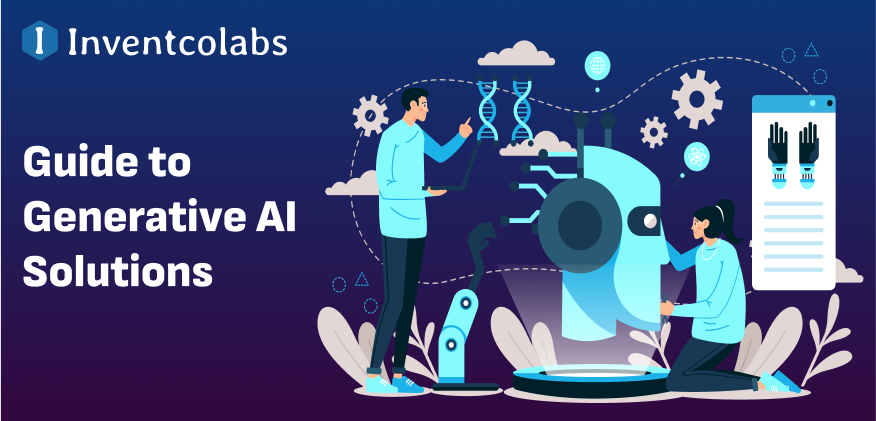The ease of employing new UI design that allows users to quickly and easily create high-quality material, and videos has generated a lot of excitement recently about generative AI. An excellent business proposition for entrepreneurs and company founders looking to bootstrap their ventures is generative AI solutions. This thorough tutorial will lead you through the necessary actions and things to think about before starting to build your generative AI model.
What is generative AI?
With the use of vast information repositories, generative AI business applications create new content such as software code, images, movies, music, and stories. A subclass of artificial intelligence known as “gen AI” can create text, images, whole databases, and other types of material on its own. It uses a range of human input and learned data to generate the content.
By changing the learning algorithms or model structures of generative AI apps, researchers can adapt these Gen AI models to fit particular domains and tasks.
Types of Generative AI Models
Different generative AI model types exist, each with its method for producing content. Among the most well-known categories of generative AI models are:
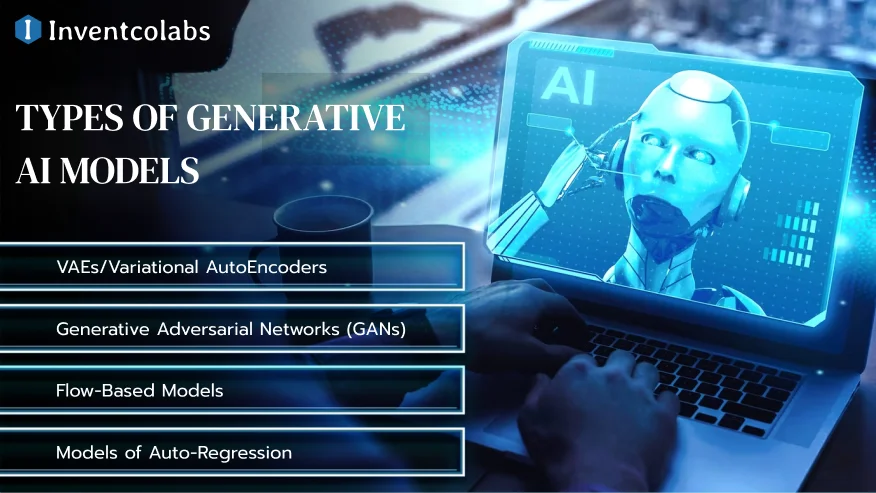
VAEs/Variational Auto Encoders:
VAEs are generative models that can rebuild the original data by first decoding it back into a latent space. They can create fresh samples from the learned distribution by learning probabilistic representations of the input data. VAEs have been applied to text and audio-generating activities in addition to being often employed in picture-generation tasks.
Generative Adversarial Networks (GANs):
A GAN’s generator and discriminator cooperate to separate actual data from fake during hostile learning, with the detector aiming for more accurate outcomes.
Flow-Based Models:
Flow-based models define an invertible transformation between the input and output spaces, thereby modeling the data distribution directly. They provide effective density estimates in addition to data generation. Applications for flow-based models include anomaly detection, density estimates, and image production. They have benefits including precise sampling, flexible latent space modeling, and tractable likelihood evaluation.
Models of Auto-Regression:
Auto-regressive models create new samples by modeling the conditional likelihood of each data point, sequentially producing data, and training them to predict subsequent data points.
Why Generative AI is Important for Enterprises?
Generative AI signifies a revolutionary change in technology. It will entail significant adjustments to your personnel, organizational structure, business procedures, skill needs, and equipment. It’s time to embrace generative AI if you haven’t previously considered how it will affect your company.
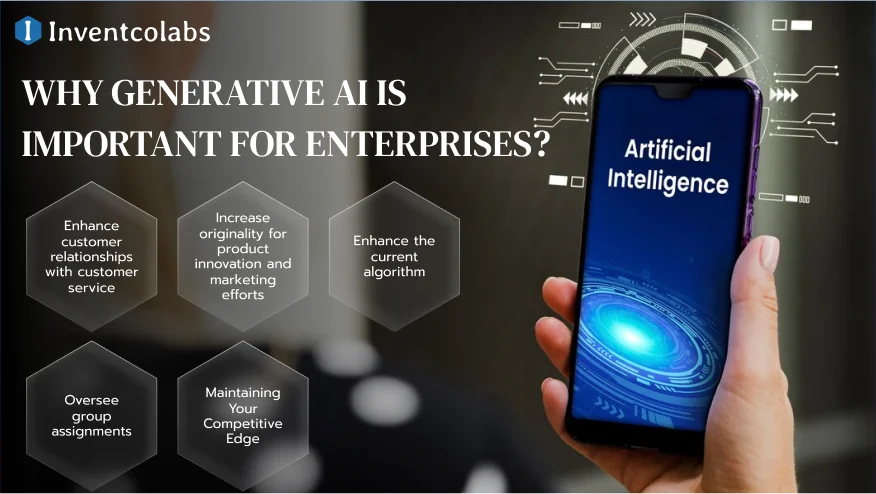
Enhance customer relationships with customer service:
Businesses are finding it difficult to satisfy consumers’ growing demands for more individualized care and quick fixes. By combining knowledge gathered from various articles and sources, generative AI app developers can swiftly construct the exact response necessary, saving clients from losing patience while service representatives search for solutions. It can then produce post-call summaries automatically.
Increase originality for product innovation and marketing efforts:
Artificial Intelligence in mobile apps can enhance creativity and speed up market launches, enhancing the creative process and enabling faster idea materialization, thereby boosting human creativity by enabling team members to assess and improve outcomes.
Enhance the current algorithm:
Generative AI enhances current algorithms by producing data for deep learning architectures and training neural networks, a method of automatic machine learning that creates more machines.
Oversee group assignments:
Gen AI automates repetitive, high-volume processes, such as Artificial Intelligence app development or the processing of insurance claims and correspondence. Facilitate the understanding of all the important unstructured data by your teams, including contracts, invoices, customer reviews, policies, and performance reviews.
Maintaining Your Competitive Edge:
It’s unlikely that the AI race will slow down. According to Accenture, 90% of business executives use an AI app development company to address various aspects of their business. Additionally, small firms can leverage AI more and more as it becomes more widely available. You can use generative AI models to analyze the market, come up with creative solutions for novel issues, and provide your stakeholders and customers with excellent work.
How to build a generative AI solution
Developing AI app development solutions necessitates a thorough comprehension of the technology as well as the particular issue that has to be resolved.
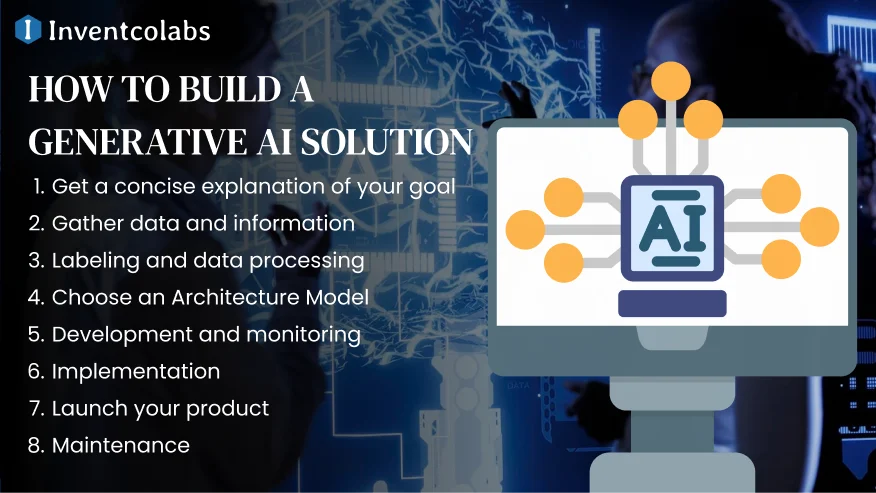
Get a concise explanation of your goal:
You need to be very clear about the problem you want to solve with custom AI solutions before you start creating code. Since the latter is designed to address certain issues, it will be harder for you to come up with a solution the less certain you are about the issue you’re trying to tackle.
Gather data and information:
Generative AI models require manual data collection from various sources, followed by cleaning, organizing, and normalizing to ensure fit for machine-learning systems.
Labeling and data processing:
After data has been gathered, it needs to be cleaned up and prepared for training. This entails normalizing the data to a standard scale, cleaning it to remove mistakes, and enriching the dataset to increase its depth and richness. Data labeling is crucial after these stages. To enable better AI learning, this entails manually annotating or classifying data.
Choose an Architecture Model:
Selecting the model architecture comes next once the data has been pre-processed. Selecting the kind of model, how many layers there are, and how many neurons there are in each layer are all included in this. The model training stage is the key component of generative AI. The model is given the prepared data and trained to recognize and replicate patterns using methods such as neural networks and deep learning. A basic model needs to be fine-tuned after it has been sufficiently trained.
Development and monitoring:
Deployment of generative AI requires ethical considerations, guided by responsibility, openness, and fairness. Regular observation, system metrics analysis, feedback gathering, and inspections ensure the model remains ethically sound, accurate, and efficient in real-world scenarios.
Implementation:
Develop generative AI applications with a deployment pipeline for reliability, replicable, and scalable deployment. Ensure efficiency, security, and dependability by considering the model’s environment, interfaces, and security measures.
Launch your product:
Finally, now that the AI solution has been trained, it’s time to put the finished result into use. The Mobile app development company defines the UI (user interface) and its scope at this point.
Maintenance:
Create a maintenance schedule to update and enhance the generative AI solution regularly, taking user feedback into account and fixing any problems or errors that crop up. Iterate the model and system continuously in response to user needs and approaches for generative AI application development.
Best Practices for Building a Generative AI Solution
A few best practices to think about while integrating generative AI are as follows:
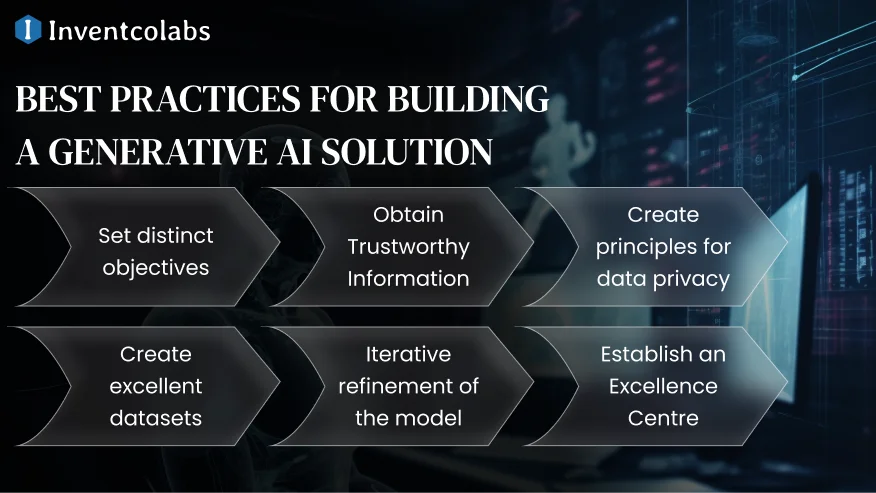
Set distinct objectives:
It is crucial to understand the problem you are attempting to solve before choosing an AI solution of this type. If you hire dedicated developers with appropriate objectives, you will incorporate all feasible resolutions into your app.
Obtain Trustworthy Information:
For a model to be created, high-quality data that matches the current situation is required. You may make sure your data is accurate and useful to prepare and tidy it.
Create principles for data privacy:
To avoid data breaches, unauthorized access, and the exploitation of confidential information, generative AI systems require appropriate control. Establishing a data governance structure is a crucial recommended practice for businesses utilizing generative AI technology to reduce risk. Developing policies that specify exactly what may and cannot be used helps to prevent problems with bias, plagiarism, and false information.
Create excellent data sets:
The quality of the training dataset has a big impact on the model’s performance. Prioritize the preparation of high-quality datasets to minimize performance problems such as bias and undergeneralization.
Iterative refinement of the model:
Iterations are common for developing generative AI solutions. Artificial Intelligence app development company begins with a basic model architecture and iteratively improves it in response to comments and assessment findings. Try varying the model setups, loss functions, and hyperparameters to maximize the performance and provide better results.
Establish an Excellence Centre:
Generative and predictive AI technologies have the potential to disrupt business, but if you hire an AI Developer and invest in an AI discovery, an integration center is crucial for effective implementation.
Read more: How To Create An Artificial Intelligence App?
Generative AI Applications Across Industries
Gen AI has numerous uses due to its exceptional capacity to analyze and comprehend enormous volumes of data.
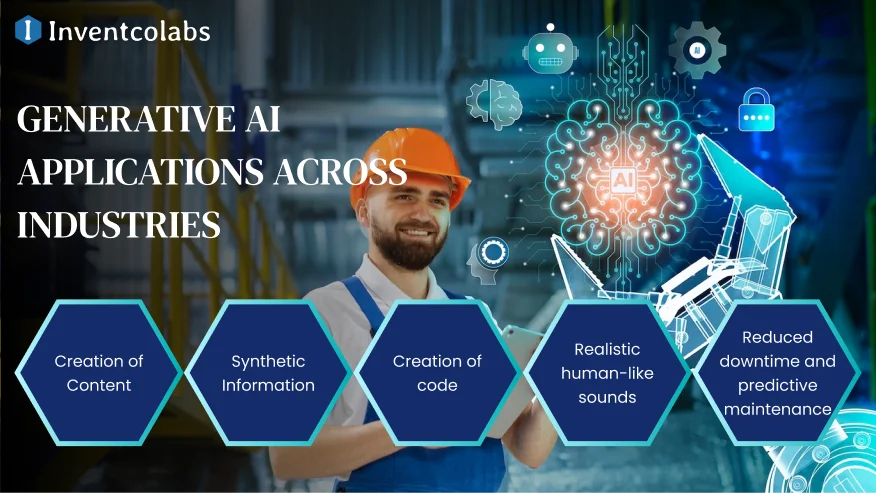
Creation of Content
-
Text:
ChatGPT, a generative AI system, can produce material and have conversations with people. -
Image generation:
From seed photos, scenes, objects, and human faces are produced. It can produce authentic photos. -
Text-to-image translation:
Programmes such as DALL-E may translate descriptions of things like flowers and birds into pictures. -
Additional content:
Software code, 3D printing, and other tasks can be written by generative AI.
Synthetic Information
One technique for producing synthetic data is generative AI. Instead of being directly observed in the real world, this type of data is created. By doing this, the privacy of the data source that the model was trained on is guaranteed. For research and analysis reasons, for instance, it is possible to artificially generate health data without disclosing the name of the patient, whose medical records are kept private.
Creation of code
Generative AI is widely used in code generation, automating tedious coding processes and allowing developers to focus on higher-level design and problem-solving, thus expediting AI application development.
Realistic human-like sounds
Realistic human-like speech creation is made possible by AI technologies, which is a useful feature for animations and avatars in video games. This feature adds a level of authenticity that enhances the overall gaming experience. In the entertainment sector, generative Artificial Intelligence has several uses, ranging from virtual reality game development to video editing and music production.
Reduced downtime and predictive maintenance
Generative AI analyzes sensor data from machines to anticipate possible malfunctions, enabling equipment manufacturers to schedule maintenance and repairs ahead of time. By reducing downtime, this tactical strategy improves the overall performance and operational efficiency of the equipment.
How Does Generative AI Work?
To produce new and unique content, AI-based app development leverages neural network models to find patterns and structures in existing data. The capacity of AI for application development to use various learning techniques, such as unsupervised or semi-supervised learning, for training is one of its innovations. As a result, businesses may now more rapidly and readily use vast volumes of anonymous data to build baseline models. As the name implies, basic models can serve as the foundation for AI systems that are capable of carrying out various tasks.
Generative AI vs Conversational AI
- Conversational AI accepts human speech as input and generates human-like replies, whereas generative AI exploits data or ideas to generate new stuff.
- Conversational AI is an algorithm that enables more organic communication between humans and technology. The discussions are similar to talking back and forth in a discussion. Generative AI uses machine learning techniques and the data it has been trained on to allow users to produce new material, including animation, text, photos, and sounds.
- GAI is flexible and works well for chatbots, content creation, creative writing, creating artwork, and composing music. Examples include the creation of text using Chat GPT and the creation of images using Mid Journey. Because CAI can converse with humans via text or speech, it is ideal for use in chatbots, virtual assistants, customer service, education, and any other situation where human-like interaction is helpful.
- While generative AI is meant to be imaginative and produce original content, conversational AI aims to respond in a way that is as natural and human-like as feasible.
The Future of Generative AI
By the end of this decade, generation AI will function at a level that is halfway between that of humans. Additionally, its performance will be compared against the top 25% of individuals who do all of these jobs before 2040. IDC predicts a CAGR of 73.3% in business spending on infrastructure, software, and AI application development services from $16 billion in 2023 to $143 billion in 2027. Generative AI offers new and creative methods to increase revenue, reduce AI app development costs, increase productivity, and improve risk management. It will soon turn into a differentiator and competitive advantage.
Explore more: AI in the Air: How AI is Reshaping the Aviation Industry
Conclusion
Generative AI can completely transform how companies run across a range of industries. Efficiency, automation, and new ideas are added to professions and work responsibilities. We’ve demonstrated the tech stack that many businesses employ as well as how to create generative AI solutions. However, experience is still a key component in creating useful AI solutions that customers find satisfactory.
FAQs
Q. Is the future major thing generative AI?
ANS. Generative AI has the potential to completely transform a wide range of sectors and facets of our daily lives in the future.
Q. What makes generative AI popular?
ANS. Generative AI platforms enhance content development efficiency, profitability, and creativity by reducing costs and time, enabling new business models and applications.
Q. Can humans be replaced by generative AI?
ANS. Generative AI can transform employment by replacing repetitive tasks with creative, emotional intelligence, and sophisticated problem-solving roles, rather than replacing humans entirely.
Q. What issue is resolved by generative AI?
ANS. Generative AI can help organizations identify patterns, trends, and potential data issues, enabling proactive problem-solving and risk reduction.
